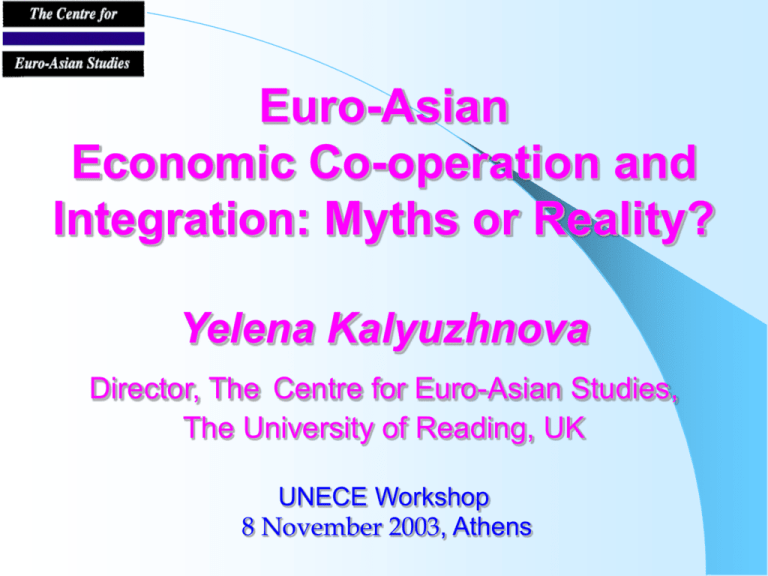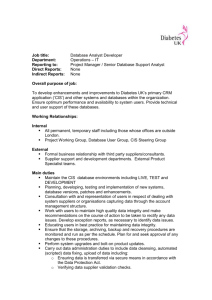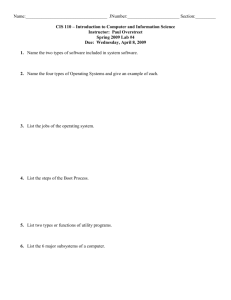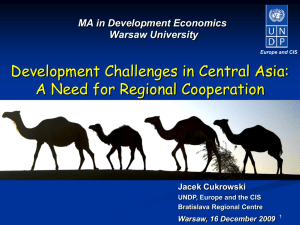Euro-Asian economic cooperation and integration: Myth or reality?
advertisement

Euro-Asian Economic Co-operation and Integration: Myths or Reality? Yelena Kalyuzhnova Director, The Centre for Euro-Asian Studies, The University of Reading, UK UNECE Workshop 8 November 2003, Athens Contents Objectives of Regulatory Convergence The Common Economic Zone within the CIS Energy and Economies Interregional Trade: Example of Gas Central Asia's Emerging Energy Market Objectives of Regulatory Convergence Foster cooperation between countries with developed and developing regulatory systems Ensuring safe and effective products Promoting technological innovation Facilitating international trade Information exchange for countries with developing regulatory systems The Common Economic Zone within the CIS On 19 September 2003 the presidents of Russia, the Ukraine, Kazakhstan and Belarus signed the founding document to establish a "Common Economic Zone" (CEZ). Glossary: Economic zone Grouping of countries with some common economic features. Examples of such economic zones are: · EU15 (Member States of the European Union) · Euro-zone (Member States who have adopted the Euro: sometimes referred to as EUR 11 or, from 1 January 2001, EUR 12) · EFTA (Countries of the European Free Trade Association) · OPEC (Member States of the Organisation of Petroleum Exporting Countries) · NAFTA (Countries of the North American Free Trade Agreement) · CEZ ???? The Common Economic Zone within the CIS The desire to “have a co-ordinated economic policy on several fronts, to harmonies the relevant legislations, and to create a single, independent, regulatory commission on trade and tariffs”. The Common Economic Zone within the CIS The agreement envisage free movements of Goods and services Capital Labour The Common Economic Zone within the CIS CIS Eurasian Economic Union GUUAM [GeorgiaUkraine-UzbekistanAzerbaijan-Moldova] CEZ ??? Example of turbulent integration in the past: Energy Sector The interested parties Transit routes Hydrocarbon in Euro-Asia Emerging energy market of Central Asia: lessons to be learnt Transit Routes Fragile Security remains a substantial problem Finding alternate land-sea routes is a difficult venture Euro-Asia – Oil Pipelines The Ukraine – Oil Pipelines Source: Centre for Global Energy Studies Euro-Asia – Gas Pipelines Energy and Water Issues in Central Asia Upstream countries Kyrgyzstan Tajikistan POSSESSING: -Water -Hydropower resources LACKING: -Oil and Gas resources Downstream countries CONFLICT OF INTERESTS Kazakhstan Uzbekistan Turkmenistan POSSESSING: -Oil, Gas, Coal LACKING: -Water resources Conclusion The early years of independence saw a sharp decline in most sectors of these economies and increasing disintegration of the economic links between them, which highlighted their interdependence. Control over the economic integration and co-operation is connected to the desire for power in the region. The success of any further economic integration will be highly dependent on the policies adopted by the governments.




